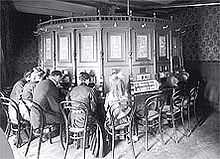Kaiserpanorama

The Kaiserpanorama (or Kaiser-Panorama) is a form of stereoscopic entertainment medium used chiefly in the 19th and early 20th centuries, a precursor to film, invented by August Fuhrmann (1844 – 1925). It was patented by the inventor ca. 1890. There would be a number of viewing stations through which people would peer through a pair of lenses showing a numer of rotating stereoscopic glass slides. By 1910 he is said to have controlled exhibitions in over 250 branches across Europe, and in the central archive have up to 100,000 slides stored.
Description

A kaiserpanorama would normally have around 25 wooden stations, each with a pair of viewing lenses. Inside the device there would be a rotating mechanism showing numerous stereoscopic images on rear-illuminated glass, giving a 3D effect.
Reconstructions
Various modern reconstructions as well as few authentic, remaining kaiserpanoramas exist in the Munich Stadtmuseum, Wels, German Historical Museum, the Märkisches Museum (Berlin), Neugersdorf, the Pioneer Settlement Museum (Swan Hill, Australia), Muzeum Kinematografii (Lodz, Poland), Deutsches Technikmuseum (Berlin), the Dusseldorf Film Museum and Teylers Museum (Haarlem, Holland). Another example is the Warsaw Fotoplastikon, built in 1905, which, despite very similar design, is not under the name kaiserpanorama. There is a dismantled kaiserpanorama in Snibston Discovery Museum in Coalville, Leicestershire, UK.
References
External links
- http://www.aiq.talktalk.net/3D/kaiserpanorama.htm
- http://inthejungleofcities.wordpress.com/2011/02/06/the-kaiser-panorama/
- http://ignomini.com/photographica/stereophotovintage/kaiserpanorama/kaiserpanorama.html